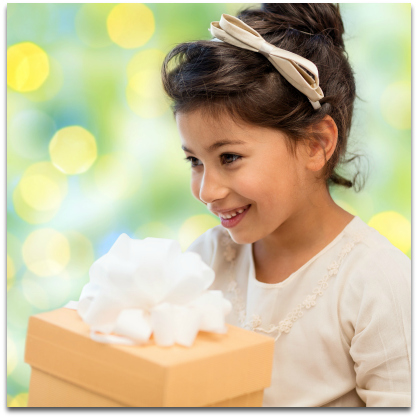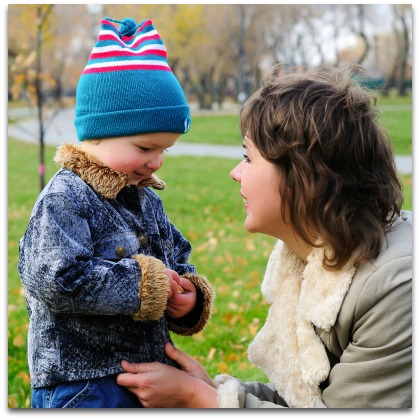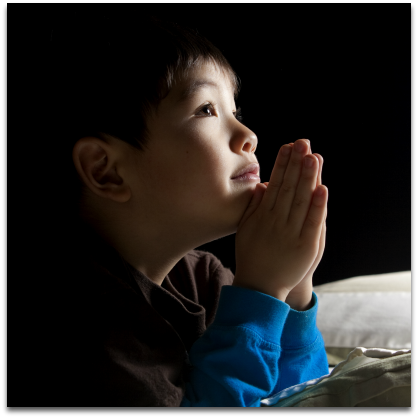 In our house, Christmas is a work in progress, as far as gratitude goes.
In our house, Christmas is a work in progress, as far as gratitude goes.
Last year we celebrated with just our small, immediate family. And thankfully (or maybe not), there were not a ton of presents underneath our tree. Most of them were either for our older son or for the entire family, so we let him have the pleasure of opening them.
Not surprisingly, we found ourselves repeating a refrain familiar to parents everywhere during the holidays and at birthday parties:
Slow down!
Take time to look at it!
This is not a race!
What we really meant, of course, is that we want our kids to actually appreciate the gifts they’re given. Birthdays and holidays should be more than just a flurry of presents and torn wrapping paper. Everyone likes receiving gifts, but it’s important that we take the time to acknowledge them.
And, more important still, to be thankful for them.
Saying “thank you” is a great start. Maybe give a hug, if both parties feel so inclined. At the least, we want time to mentally note who gave what so that cards can be sent later.
Fact is, we know that our children appreciate the gifts they’re given. Just as they appreciate the other important parenting roles we play.
When our kids are babies, of course, we don’t expect gratitude. We’re content to be their whole world—for those first few months, anyway. We don’t expect to be thanked for getting up to feed an infant in the middle of the night, or for carefully bathing them so as to not get soap in their delicate eyes.
As they get older, we can see more clearly that we are loved and appreciated and needed. They might not say so in words, but there’s no mistaking the happy grin of a baby who’s just been offered the breast or the way a child clings to your neck after taking a tumble.
It’s the heavy weight of a child asleep in your arms. It’s the tight grip of a tiny hand as you splash together in a giant puddle. We can hear it in their laughs and feel it in the way they intrinsically trust us.
We are our child’s safe place. We are needed. We are enough.
We are appreciated.
Of course, one of the challenges of parenting is eventually teaching them to take their gratitude to the next level. It starts with being thankful for special things—birthday presents, a trip to the movies, a cookie from the coffee shop.
Ultimately, though, we want them to learn to be thankful for the everyday, intangible things, too. The presence of family members. A warm, safe home. Healthy food to eat. A civil society.
And therein lies the challenge.
There is no one way to cultivate gratitude in the minds and souls of our little ones. But here are some ideas to keep in mind.
Do As I Say, And Also As I Do
 Perhaps the most important factor in teaching gratitude, as with so many other things in parenting, is showing it yourself.
Perhaps the most important factor in teaching gratitude, as with so many other things in parenting, is showing it yourself.
Jeffrey Froh and Giacomo Bono, psychologists that study prosocial behaviors in children, remind us that “Our children want to be like us. We provide the blueprint for what to say and what to do and in what contexts.”
When the barista hands you your latte, do you say thank you? Do you thank the waiter for bringing your meal? Do you thank the person who holds open the door at the post office?
Do you thank the cashier at the grocery store? The person behind the counter at the DMV? The librarian who just helped you find a book?
If you want your children to be thankful for the things they receive in life, whether toys or books or food or even services rendered, then you need to be thankful, too. And they need to see that.
Strive to be visibly appreciative of things others do for you. Your kids are watching and they will notice.
Seek Teachable Moments
 We don’t expect perfection from our kids. There will be times when they forget to say thank you, or when they grab that new toy from Grandma’s suitcase and rush it to another room to play.
We don’t expect perfection from our kids. There will be times when they forget to say thank you, or when they grab that new toy from Grandma’s suitcase and rush it to another room to play.
Sometimes, it seems like it doesn’t matter how many subtle—or not-so-subtle—reminders we give. So what’s a conscious parent to do when all the lecturing in the world just isn’t getting the point across?
We seek moments in real life to teach.
When our children forget to say thank you at the store, we give them a moment to be certain they truly forgot. We make sure they hear us thanking the clerk for our own purchase. And then, if necessary, we gently remind them.
When a good friend brings over some homemade cookies, we might remind our kids how considerate that individual was, to think of us like that.
We might use the phrase, “What do we say when someone gives us something?”
We might ask, “How can we show them how much we appreciate this gesture?”
When Grandma and Grandpa are coming to visit, we spend the drive to the airport discussing how much he missed them. We remind him of the tearful Skype conversations asking when they’d next be visiting.
So when he greets Grandma with, “Did you bring me a present?” anyway, we remind him that there are so many other reasons why we are happy to see a loved one. We redirect conversation to asking about the flight, about how Grandma’s cat has been, about the exciting things we’re planning to do over the next few days.
And when that toy finally comes out, we hope they remember to be thankful. And if they forget, well, we simply remind them again.
Focus on the Positive
 Do you ever have those days where it seems like every sentence out of your mouth begins with “No,” “Stop,” or “Don’t?”
Do you ever have those days where it seems like every sentence out of your mouth begins with “No,” “Stop,” or “Don’t?”
I know I do.
And yet, I know that kids thrive on positive comments. Some people say to aim for at least five positive statements for every negative, or maybe even a ratio of ten-to-one.
This idea can be applied to gratitude, too. If we take the time to notice—and thank—our children when they do something right, we’re calling attention to it. It shows them that we are paying attention. And that we appreciate their good behavior.
Instead of focusing on behavior that we don’t like, take note of the things they do that we’d like for them to continue.
As Janet Lansbury reminds us, “’Good job’ is a reflexive response for parents, but it is the kind of praise that feels more like an authoritative (and slightly demeaning) stamp-of-approval than a response of appreciation.”
When your five-year-old gets into his car seat the first time you ask, and even starts buckling himself in, notice and express your own gratitude. “It makes me feel really good inside when I see you getting into your car seat so quickly! Thank you!” This is ultimately more powerful than reminding him half a dozen times to stop lollygagging and get in the car already.
When she spills a cup of water, hold your tongue for a moment, and if she gets up to get a towel all on her own, say “thank you.”
When big brother brings a toy to the baby to try to quell baby sister’s crying, take notice. “Thank you. I love seeing you be such a big helper.”
Dr. Laura Markham reminds us that “Focusing on the positive makes us happy. Savoring positive emotions actually rewires the brain.”
Reinforce that positive behavior. Be outwardly thankful for it. Rewire your brain. And hopefully your child will see and do the same.
Appreciate Your Child in Creative Ways
 Building off the last idea, why not try some innovative ways of showing your child that you appreciate them?
Building off the last idea, why not try some innovative ways of showing your child that you appreciate them?
When your kids do something thank-worthy, don’t just say so out loud, although that’s a good place to start. Write it on a paper flag and stick it on a piece of poster board. Or on a leaf, and stick it to a tree. Or take a picture in your mind, asking your child to pose first so you’ll always remember this moment.
Some families have taken on the practice of making a gratitude tree at Thanksgiving. But an idea like this—taking time together, as a family, to talk about the things you’re grateful for, and creating a visual display of them—isn’t just limited to big holidays. Why not do something similar every major holiday?
You can change how the gratitude is displayed based on the holiday or time of year—gratitude clouds in the springtime, gratitude candles for Hanukkah, gratitude snowflakes for the middle of winter.
This could also easily be a monthly, or even weekly practice.
Try making a gratitude jar. Label a mason jar with your child’s name, and every time you notice them doing something kind, place a marble in it, or a popsicle stick, or even a paperclip. At the end of the week, count those grateful moments up and go out for a treat—even if it’s just a trip to the park.
Alternately, fill each child’s gratitude jar with notes detailing exactly what they did that you thought was wonderful. At dinner once a week, read the notes out loud. Watch the smiles that ensue.
And watch as your children start going out of their way to do things deserving of gratitude.
Make Gratitude a Daily Practice
 If you’re anything like most people, you have days where it feels like the world is out to get you. The kids are moving oh-so-slowly to get ready for school. You spill your coffee on the way out to the car. Someone steals your parking space.
If you’re anything like most people, you have days where it feels like the world is out to get you. The kids are moving oh-so-slowly to get ready for school. You spill your coffee on the way out to the car. Someone steals your parking space.
Some days, it’s hard to remember that we have so much to be thankful for.
But it’s so important that we do remember. And that we teach our kids to do the same.
Make gratitude a part of your everyday life. Involve your kids, so that it becomes second nature to them.
When eating together as a family, start a conversation about one thing you’re grateful for that day—and why. See where the conversation goes from there.
If you’re religious, include gratitude in your nightly prayers. If you’re not, discuss the people we’re thankful for during your bedtime routine. Or ask about the best part of your child’s day. Start a gratitude journal, and encourage your kids to do the same.
Write thank you notes for presents received. Leave tips for services received. Send unexpected letters of gratitude to the fire department, the librarian, your children’s teachers. Practice random moments of thankfulness.
And always, always encourage your kids to be thinking of more ways to express their own gratitude.
My son’s birthday is coming up, and we’ll once again be facing a test, as it were, in the gratitude department. Will he remember to say thank you to his friends for coming to his party, and for any gifts he receives? Will it just be a flurry of ripped paper and excited exclamations?
How involved will I have to be in the process of writing thank you cards?
Has my son been taking in anything, anything at all, which I’ve been trying to teach him about gratitude?
As with most aspects of a gentler style of parenting, gratitude takes time to teach. There’s no easy solution. But we’ll keep trying and teaching.
The 2-Minute Action Plan for Fine Parents
- Take the time, today, to notice at least three “good” things your child does—things you are thankful for, or things you might be tempted to simply praise. Make a point of thanking your child for doing those things.
- Find an opportunity today to show genuine gratitude while in the presence of your child. This could be as simple as saying “Thank you; have a great day” to the toll booth worker, or more complex, like sending a note of appreciation to someone you value in life or speaking to the manager at a restaurant to praise the service of your wait staff.
- At dinner tonight, or perhaps at bedtime, make a point of asking your child something they are grateful for today. If that question draws a blank, try rephrasing it. What was the best part of their day? What happened today to make them smile?
The Ongoing Action Plan for Fine Parents
- Do you regularly send thank you cards for holiday or birthday gifts you receive? Now is the time to start. Write thank you notes together. Buy pre-made ones, where you just write a simple, heartfelt message inside to personalize. Or consider getting blank cards and making a production of it with rubber stamps, glitter, stickers, watercolors, or other art supplies.
- Consider starting a family practice of gratitude journaling. You can get individual family members their own journals, or get one big, fancy book that everyone contributes to. You can use blank books—with lined pages, so the day’s thoughts can be recorded with words, or blank pages, if you want to add an artistic element to it. Specific gratitude journals are even available at bookstores and online, if having prompts might help everyone get started.
- Try to avoid simply telling your child, “say thank you.” In times where you feel gratitude is warranted, give your child a moment to remember on their own; you may be surprised to find that, given a few extra minutes, they’ll remember to offer thanks on their own. When necessary, offer a gentle reminder. Point out how nice someone’s behavior is, or quietly ask if they have anything to say. The point is to get your child thinking and feeling truly grateful, rather than offering a rote and meaningless “thank you.”
- Utilize a creative way of showing gratitude within your family. Consider tracking daily instances of gratitude with a gratitude jar. Make gratitude trees. Help your kids become more intentional about recognizing behavior that merits gratitude, both in themselves and in others.
Greetings Holly, I really like your writing style and would value your opinion on a children’s vegetable cookbook I have just self published. I tried to be thoughtful in my cookbook and help children to make friends with vegetables by first exploring and being curious about them. I also want to show children how they can make changes to recipes for greater satisfaction, through changing the texture and/or seasoning. Children can cook and eat real food. Rebecca Katz has endorsed by book but I am searching for review from someone like yourself. Do you have any suggestions or interest to look at some pages digitally? I’d also be very happy to send you a cookbook if you like what you see. Thanks so much for taking the time to consider my request. Heide Horeth 4waystoyummy.com and fb